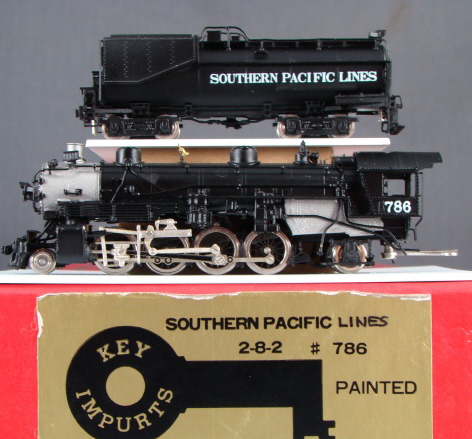

Introduced: 1990 (USRA Light Mikado) and 1991 (SP MK-5/MK-6 Mikado)
These models all come out around the same time, and as such I'm going to go ahead and assume they all share the same basic mechanism. So, I'm going to save myself a bit of time and money and review them all based on the one USRA Light Mikado I actually purchased.
In addition to the SP version pictured above, the USRA Mikados were also available in NYC class H-6, UP class 2480 and "generic" configurations -



I don't know what the whole "Yulim" story is, but whatever the case, they had a relatively brief career as far as N scale brass locomotives are concerened (consisting solely of these Mikados and a 4-8-4 Northern). Nevertheless, these are fine looking models that perform admirably.

The locomotive chassis is all metal and fairly minimalistic (with most of the actual heft being provided by the shell). The motor is an open-sided, straight-wound 5-poler. Right-rail pickup is provided by the right-side drivers. Left-rail pickup comes from the four left-side tender wheels. Current is transferred from the tender to the motor via the metal drawbar (aided by a stiff metal wire affixed to said drawbar). Only the center pair of drivers are geared (the others being turned solely by the valve gear). Apart from the brass worm gear, all the gearing is plastic. There is no lighting. A dummy (non-opertional) coupler is mounted to the pilot. There is no coupler on the tender, although a Micro-Trains friendly pocket is provided. Wheels are low profile, so no problems on Code-55 rails. The second pair of drivers (from the front) is equipped with traction tires. And in an odd switch, a replacement driver pair is included in the box - but also with traction tires! Go figure.
Despite the relatively primitive electrical conductivity scheme (IE, the drawbar), overall performance is quite solid. It runs smoothly and quietly at all throttle levels. Pulling power is strong, slow speed creep is excellent, and pickup is quite respectable (although the drawbar connection seems to be more reliable when the locomotive is actually pulling some cars). No problems derailing on narrow radius curves. On the minor quibble front, the top-end speed is excessive (so, y'know, don't give it that much throttle).
Given the dated design, I can't quite give these models an "A" rating. But overall, they're very nice looking steamers that certainly run well enough to join an operational fleet.
To remove the locomotive shell, first unscrew the two black screws on the back of the cab. Next, you need to unscrew the silver screw underneath the pilot truck. I couldn't figure out an easy way to get said pilot truck out of the way, so I wound up removing the entire bottom plate. Once the silver screw is out, the shell should lift off readily.
Grade: B